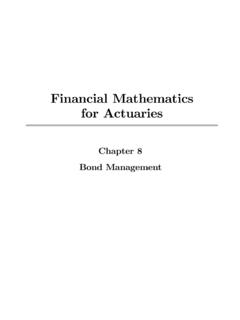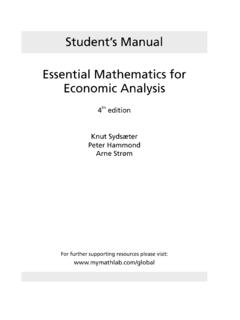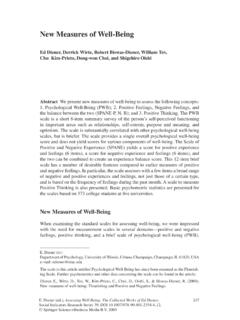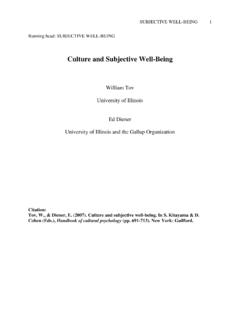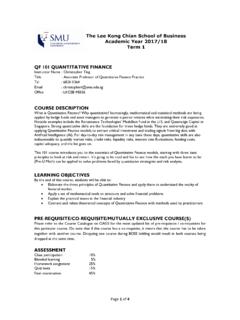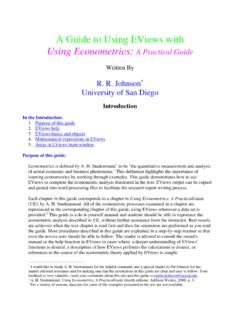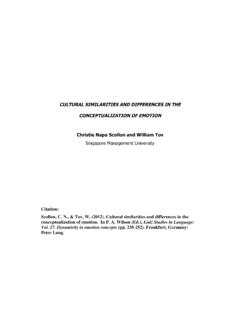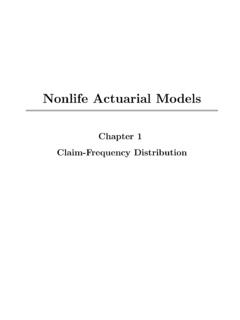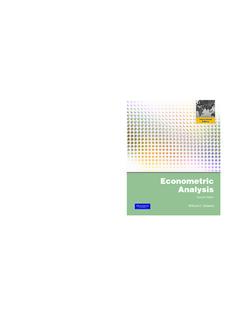Transcription of Financial Mathematics for Actuaries - mysmu.edu
1 Financial Mathematicsfor ActuariesChapter 2 AnnuitiesLearning Objectives1. Annuity-immediate and annuity-due2. Present and future values of annuities3. Perpetuities and deferred annuities4. Other accumulation methods5. Payment periods and compounding periods6. Varying Annuity-Immediate Consider an annuity with payments of 1 unit each, made at the endof every year fornyears. This kind of annuity is called anannuity-immediate(also calledanordinary annuityor anannuity in arrears). Thepresent value of an annuityis the sum of the present valuesof each :Calculate the present value of an annuity-immediate ofamount $100 paid annually for 5 years at the rate of interest of 9%.Solution:Table summarizes the present values of the payments aswell as their :Present value of annuityYear Payment ($) Present value ($)1100100 ( ) 1= ( ) 2= ( ) 3= ( ) 4= ( ) 5= Weareinterestedinthevalueoftheannuityatt ime0,calledthepresent value, and the accumulated value of the annuity at timen,called the future Suppose the rate of interest per period isi,andweassumethecompound-interest method applies.
2 Letaneidenote the present value of the annuity, which is sometimesdenoted asanewhen the rate of interest is understood. As the present value of thejth payment isvj,wherev=1/(1 +i)isthe discount factor, the present value of the annuity is (see for the sum of a geometric progression)ane=v+v2+v3+ +vn=v 1 vn1 v =1 vni=1 (1 +i) ni.( )5 The accumulated value of the annuity at timenis denoted bysneiorsne. This is the future value ofaneat ,wehavesne=ane (1 +i)n=(1 +i)n 1i.( ) If the annuity is of level payments ofP, the present and future valuesof the annuity arePaneandPsne, :Calculate the present value of an annuity-immediate ofamount $100 paid annually for 5 years at the rate of interest of 9% usingformula ( ). Also calculate its future value at :From ( ), the present value of the annuity is100a5e=100 "1 ( ) #=$ ,which agrees with the solution of Example The future value of theannuity is( )5 (100a5e)=( )5 = $ , the future value can be calculated as100s5e=100 "( )5 #=$ :Calculate the present value of an annuity-immediate ofamount $100 payable quarterly for 10 years at the annual rate of interest7of 8% convertible quarterly.
3 Also calculate its future value at the end of10 :Note that the rate of interest per payment period (quarter)is(8/4)% = 2%,andthereare4 10 = 40payments. Thus, from ( ) "1 ( ) #=$2, ,and the future value of the annuity-immediate ( )40=$6, A common problem infinancial management is to determine the in-stallments required to pay back a loan. We may use ( ) to calculatethe amount of level installments :A man borrows a loan of $20,000 to purchase a car atannual rate of interest of 6%. He will pay back the loan through monthlyinstallments over 5 years, with thefirst installment to be made one monthafter the release of the loan. What is the monthly installment he needs topay?Solution:The rate of interest per payment period is(6/12)% = the monthly installment. As there are5 12 = 60payments,from ( ) we have20,000= "1 ( ) #=P ,9so thatP=20, $ The example below illustrates the calculation of the required install-ment for a targeted future :A man wants to save $100,000 to pay for his son seducation in 10 years time.
4 An education fund requires the investors todeposit equal installments annually at the end of each year. If interest is paid, how much does the man need to save each year in order tomeet his target?Solution:Wefirst calculates10e, which is equal to( )10 the required amount of installment isP=100,000s10e=100, $7, Annuity-Due Anannuity-dueis an annuity for which the payments are made atthe beginning of the payment periods Thefirst payment is made at time 0, and the last payment is madeat timen 1. We denote the present value of the annuity-due at time 0 by anei(or ane), and the future value of the annuity at timenby snei(or sne). The formula for anecan be derived as follows ane=1+v+ +vn 1=1 vn1 v=1 vnd.( )12 Also, we have sne= ane (1 +i)n=(1 +i)n 1d.( ) As each payment in an annuity-due is paid one period ahead of thecorresponding payment of an annuity-immediate, the present valueof each payment in an annuity-due is(1+i)times of the present valueof the corresponding payment in an annuity-immediate.
5 Hence, ane=(1+i)ane( )and, similarly, sne=(1+i)sne.( )13 As an annuity-due ofnpayments consists of a payment at time 0and an annuity-immediate ofn 1payments, thefirst payment ofwhichistobemadeattime1,wehave ane=1+an 1e.( ) Similarly, if we consider an annuity-immediate withn+1paymentsat time 1, 2, ,n+1as an annuity-due ofnpayments starting attime 1 plus afinal payment at timen+1, we can concludesn+1e= sne+1.( )Example :A company wants to provide a retirement plan for anemployee who is aged 55 now. The plan will provide her with an annuity-immediate of $7,000 every year for 15 years upon her retirement at the14age of 65. The company is funding this plan with an annuity-due of ,whatistheamountofinstallmentthecompany should pay?Solution:Wefirst calculate the present value of the retirement is equal to7,000a15e=7,000 "1 ( ) #=$72, amount should be equal to the future value of the company s install-mentsP,whichisP ( ),wehave s10e=( )10 11 ( ) 1= ,so thatP=72, $5, Perpetuity, Deferred Annuity and AnnuityValues at Other Times Aperpetuityis an annuity with no termination date, ,n.
6 An example that resembles a perpetuity is the dividends of a pre-ferred stock. To calculate the present value of a perpetuity, we note that, asv<1,vn 0asn . Thus, from ( ), we havea e=1i.( ) For the case when thefirst payment is made immediately, we have,from ( ), a e=1d.( )16 Adeferred annuityis one for which thefirst payment starts sometime in the future. Consider an annuity withnunit payments for which thefirst pay-ment is due at timem+1. This can be regarded as ann-period annuity-immediate to start attimem,anditspresentvalueisdenotedbym|a nei(orm|anefor short).Thus, we havem|ane=vmane=vm 1 vni =vm vm+ni=(1 vm+n) (1 vm)i17=am+ne ame.( ) To understand the above equation, see Figure From ( ), we haveam+ne=ame+vmane=ane+vname.( ) Multiplying the above equations throughout by1+i,wehave am+ne= ame+vm ane= ane+vn ame.
7 ( ) We also denotevm aneasm| ane,whichisthepresentvalueofan-payment annuity of unit amounts due at timem, m+1, ,m+n If we multiply the equations in ( ) throughout by(1 +i)m+n,weobtainsm+ne=(1+i)nsme+sne=(1+i) msne+sme.( ) See Figure for illustration. It is also straightforward to see that sm+ne=(1+i)n sme+ sne=(1+i)m sne+ sme.( ) We now return to ( ) and write it assm+ne=(1+i)m+nam+ne,19so thatvmsm+ne=(1+i)nam+ne,( )for arbitrary positive integersmandn. How do you interpret this equation? Annuities Under Other Accumulation Methods We have so far discussed the calculations of the present and futurevalues of annuities assuming compound interest. We now extend our discussion to other interest-accumulation meth-ods. We consider a general accumulation functiona( )and assume thatthe function applies to any cash-flow transactions in the future.
8 As stated in Section , any payment at timet>0starts to accu-mulate interest according toa( )as a payment made at time 0. Given the accumulation functiona( ), the present value of a unitpayment due at timetis1/a(t),so that the present value of an-21period annuity-immediate of unit payments isane=nXt=11a(t).( ) The future value at timenof a unit payment at timet<nisa(n t), so that the future value of an-period annuity-immediateof unit payments issne=nXt=1a(n t).( ) If ( ) is satisfied so thata(n t)=a(n)/a(t)forn>t>0,thensne=nXt=1a(n)a(t)=a(n)nXt=11a(t) =a(n)ane.( ) This result is satisfied for the compound-interest method, but notthe simple-interest method or other accumulation schemes for whichequation ( ) does not :Suppose (t)= t 5, :Wefirst calculatea(t), which, from ( ), isa(t)=exp =exp( ).Hence, from ( ),a5e= + + + + ,and, from ( ),s5e=1+ + + + thata(5) = ,sothata(5)a5e= = Note that in the above example,a(n t)=exp[ (n t)2]anda(n)a(t)=exp[ (n2 t2)],so thata(n t)6=a(n)/a(t)and ( ) does not :Calculatea3eands3eif the nominal rate of interest is5%per annum, assuming (a) compound interest, and (b) simple :(a) Assuming compound interest, we havea3e=1 ( ) ,ands3e=( )3 = (b) For simple interest, the present value isa3e=3Xt=11a(t)=3Xt=111+rt= + + ,andthefuturevalueattime3iss3e=3Xt=1a(3 t)=3Xt=1(1 +r(3 t)) = + + the same nominal rate of interest, the compound-interest method gen-erates higher interest than the simple-interest method.
9 Therefore, thefuture value under the compound-interest method is higher, while itspresent value is lower. Also, note that for the simple-interest method,a(3)a3e= = , which is different froms3e= Payment Periods, Compounding Periods andContinuous Annuities We now consider the case where the payment period differs from theinterest-conversion :Find the present value of an annuity-due of$200perquarter for 2 years, if interest is compounded monthly at the nominal rateof 8%.Solution:Thisisthesituationwherethepa ymentsaremadelessfrequently than interest is converted. Wefirst calculate the effective rateof interest per quarter, which is 1+ 3 1= there aren=8payments, the required present value is200 "1 ( ) 81 ( ) 1#=$1, :Find the present value of an annuity-immediate of$100per quarter for 4 years, if interest is compounded semiannually atthe nominal rate of 6%.
10 Solution:This is the situation where payments are made more fre-quently than interest is converted. Wefirst calculate the effective rate ofinterest per quarter, which is 1+ 12 1= , the required present value "1 ( ) #=$1, It is possible to derive algebraic formulas to compute the presentand future values of annuities for which the period of installment isdifferent from the period of compounding. Wefirst consider the case where payments are made less frequentlythan interest conversion, which occurs at time 1, 2, ,etc. Letidenote the effective rate of interest per interest-conversion pe-riod. Suppose am-payment annuity-immediate consists of unit pay-ments at timek,2k, , ,whichisthenumber of interest-conversion periods for the Figure illustrates the cashflows for the case ofk=2. Thepresentvalueoftheaboveannuity-immedia teis(weletw=vk)vk+v2k+ +vmk=w+w2+ +wm=w 1 wm1 w =vk 1 vn1 vk =1 vn(1 +i)k 1=aneske,( )and the future value of the annuity is(1 +i)naneske=sneske.
